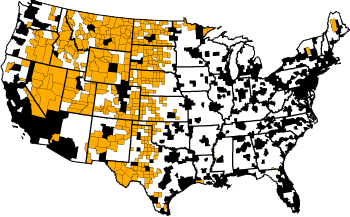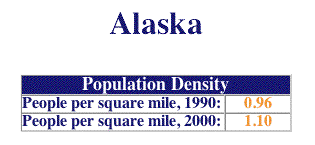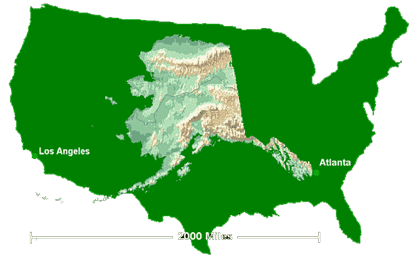Some Background Information
This page provides some key information about Alaska for those who are considering moving here to teach or work as school administrators. If you are looking for information about specific school districts, please see our Alaska School Districts page.Our aim here is not to give you the travel brochure version of Alaska, but to give potential teachers a short course in some of the features of our state that don't always find their way into tourist pamphlets.
According to the Institute of Social and Economic Research, only about 30% of teachers in Alaska were actually educated here, so you will be among friends. The other 70% of us moved up at one point or other and feel that you should know what to expect— even if we didn't. One of the things you will notice is the peculiar habit many Alaskans have of mentioning how long they've been in the state.
We still call Alaska home. Remember that although rural and remote districts in Alaska have higher average teacher turnover rates in general than road system districts, there are many exceptions. Some of the lowest overall turnover rates in the state are in Bristol Bay, and some of the highest in certain years are in road or ferry system villages.
Not Just Another Pretty Place
Alaska is more than just a pretty place. It is quite unique, and many who have done both compare living and working in rural and remote parts of Alaska more to working overseas than elsewhere in the United States. This is because the rural parts of the state frequently require newcomers to adapt to both a different culture and a completely different way of day-to-day life. See our Teaching in Alaska page for more detailed information.
It is not uncommon for first time visitors to come up for a Job Fair or even accept a teaching or principal job without fully appreciating some important basic geographic and demographic facts about our state.
We want you to be able to make informed decisions about your potential move; to help you we have compiled some great links to sources of information about Alaska on this page. If you accept a job, you will want to see specific resources on our site about moving to Alaska, transportation logistics, what to bring when you come up, and how to ship your stuff up here to your new home.
You will need to learn some new vocabulary terms in order to make sense of Alaska as a potential new home. The first of these are the designations that all communities typically fall under:
On the Road System
This means you can drive to that community from, say, Oklahoma, if you have time, gasoline and determination. Most roads in Alaska are two lane, and not necessarily paved in any recognizable fashion. Tar and chip isn't "paved" unless you've lived in the Bush. The Alaska Highway comes up through Canada, and connects us to the Lower 48.
The main highway system connecting Alaska to the Lower 48 is the Alcan Highway which comes into Alaska at Tok, near the Canadian border. The Alcan meets the Richardson highway which runs up to Fairbanks in the north, or the Glenn Highway which runs west to Anchorage. The Parks Highway connects Anchorage and Fairbanks. The Sterling Highway heads south from Anchorage to the Kenai Peninsula.
Most Bush residents consider coastal communities on the "Road System" if the Alaska Marine Highway System ferries serve that village on a regular schedule, such as most of those in Southeast Alaska.
Examples of school districts "on the road" would be Anchorage, Kenai Borough Peninsula, Mat-Su, Fairbanks, and Denali Borough. Juneau is connected by ferry to Washington state, as are most of the smaller towns and villages in Southeast.
In the Bush
Well, everything else is pretty much in the Bush.
The vast majority of the state's communities are in rural or remote Alaska, also know as "the Bush". To get to the Bush, you have to fly or take a boat. Although some regional hub communities have a local system of roads, with the occasional car or truck, they are not connected to the rest of the roads in the state, or North America, for that matter.
Some of these, like Nome, really allow you to drive quite a ways – hours in fact – but, you still need to either fly your car there by air cargo, or send it by barge. Other example hubs with limited road systems – don't expect pavement – would be Dillingham, McGrath, Barrow, and Kotzebue.
Most villages, though, are fly in only. Typically, this transportation is via a small plane. We are talking about somewhere between perhaps 10 other people, and nobody but you and the pilot. On the upside, you won't have to take your shoes off at the airport and you can keep your beverages with you when you board. You will sometimes fly on a twin turbo prop from Anchorage to a hub community, and then transfer to a smaller, single engine plane. Landings are on a dirt strip, sometimes using skis in the winter, setting down on an "ice runway" smoothed out of the frozen sea.
It is not uncommon in any area of the state to be "weathered in", or "weathered out" for a few days. This happens when the planes can't fly into, or out of a community. It will happen to you at least once if you live here. Air service schedules are nothing more than rough approximations of when they would like to fly to a place. If the pilots don't want to fly, you don't either. Travel with a book to read.
Alaska is actually designated a "frontier area", and certainly it is the last frontier for educators in North America. Only some remote parts of Canada can compare in terms of maintaining schools in areas with frontier characteristics. Australia, too, has some isolated regions with small schools.
According to the Rural Policy Research Institute, the majority of Alaska can only fit into the category of a frontier.
- Alaska is "completely rural", according to the ERS/USDA Rural Continuum Codes since nearly the entire state is "less than 2,500 urban population, not adjacent to a metro area".
- The U.S. Census Bureau defines "Frontier" areas as "less that 6 people per square mile". Alaska averages roughly one person per square mile. Some sources using the same 2000 census data just put the average as "under one per square mile".
| Frontier Areas in the United States | How Does Alaska Compare? |
 |
Frontier Area? Less than 6 people per square mile  |
| Source: U.S. Census Bureau | |
The scale of Alaska is misleading on most maps. This overlay shows how Alaska compares to the size of the Lower 48. If you teach on the island of Atka, in the western Aleutians, then you are as far from the capital of Juneau as Los Angeles, California is from Atlanta, Georgia. Alaska still has two time zones, and it used to have four.
| Alaska Compared to the Lower 48 States |
 |
| Over 2000 miles East to West - 656,424 square miles! |
Alaska has several very distinct climate zones – three major divisions, and several transition zones. We are talking about extremes that may well influence where you want to work.
Since Alaska stretches 1100 miles north to south, there is also a great difference in the amount of daylight in winter and summer. And, as climate determines vegetation, there are some real distinctions in the whole eyeball package each area offers.
The National Health and Environmental Effects Research Laboratory produces this excellent map and guide. This resource will tell you much about the climate and the basic geographical characteristics of each area.
The climate and vegetation zones in a paragraph are:
- Maritime Zone: southeastern Alaska, the south coast, and Aleutian islands. Much less variation in temperature over the year. Warm, wet winters. You may not even need real winter gear. Think about seam seal tape an investment. Lots of rainforest in the southeast and southcentral. Alpine tundra (no trees) in the Aleutians. Big mountains throughout. Ring of Fire.
- Maritime Continental Zone: western Bristol Bay, and western coastal. Summer cool because of open waters of the Bering Sea. Winter temperatures are more cold, and continental when the ice comes. Bring your winter gear, and your rain gear…both can be used at any time of year. Some trees. Some not. Some tundra.
- Transition Zone: Cook Inlet near Anchorage, and the northern extremes of the south coast zone. Cool summers, but warmer than the Maritime, winter not as serious as north of the Alaska Range. Your spiffy REI stuff is probably good enough. You'll be in a car anyway. Ocean, trees and mountains.
- Continental Zone: Interior, west central and Copper River area. The coldest part of Alaska. Temperatures to -70 F, and hot enough for thunderstorms in the summer. Many areas with trees, some to the north and west without. Lots of rivers. Great Northern Lights in the winter.
- Arctic Zone Brooks Range and north drainages. Serious cold, but not as cold as the Continental
Zone. You are above the Arctic Circle, so daylight is a seasonal thing. Sea ice and
polar bears. No trees. Obviously, the weather forecast for Alaska in a complex one,
and the most popular show in rural Alaska – because of the importance of weather to
local travel and safety – is KAKM's Alaska Weather. This is a detailed 30 minute long weather forecast, folks, that you can stream if
you'd like to get a feel for Alaska's weather in the various regions throughout the
year.

Map from ClimateNexus.org: https://climatenexus.org/climate-change-news/alaska-climate-change-ground-zero/
You will want to do your homework about the school districts before making your plans. We recommend that you research any districts that catch your eye, and learn all that you can about the villages.
If you are going to an ATP Job Fair, you should do your research before you get there, and bring a "hit list". Sometimes the unexpected works out. It never hurts to be prepared, but remain flexible, and think outside the box.
Know your comfort level, and the limitations of your family situation. If you want to live in a rural village, but your husband does not, you shouldn't accept a contract there.
Here are some links to help you become an expert:
- Our Researching Locations page is your best single source of information!
- Alaska's Division of Community Advocacy maintains an excellent Community Database.
Maps & Satellite Images
Visit our Alaska Maps page.
Additional Resources
Here are some additional places to go for information about Alaska. The list here will grow as we refine our website. If you have suggested resources, please email us!
» Wikipedia Article on Alaska – More basic information than you can shake a stick at! Since it's a wiki, you can contribute.

